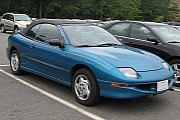history
The Pontiac car company draws its name from the town of Pontiac, Michigan, where Edward M. Murphy first established the Pontiac Buggy Company in 1893, which specialized in making horse-drawn carriages. Several years later, in 1907, when Murphy realized the future was in motor driven vehicles, he turned the buggy company into the Oakland Motor Car Company.
This company was bought by General Motors in 1909 after the timely death of its founder. The first Pontiac car was the Five Passenger Coach in 1926, introduced to the public at the new York Auto Show. It was a six-cylinder engine meant to be powerful enough to outrun the 4-cylinder cars on the road at the time, but still be cheaper than most models.
The success of this first model which sold in record numbers spawned the next six-cylinder car, the Pontiac Big Six in 1929, so named because of the increased displacement and horsepower. At first Pontiac cars were marketed by GM as a low-price version of their Oakland models, but starting with the 30s, the company tried to ditch the image for “reliable but otherwise boring” cars.
They set their eyes on a more younger market,and tried to capture their attention with faster, better looking cars such as the Torpedo Deluxe 8 and the Chieftain Super Deluxe which also came in coupe versions. A thing also worth mentioning is the fact that Pontiac was the first to offer engine options for the same car to the customer.
But the first defining model for Pontiac was the 1957 Boneville, the one who introduced the fin design that would define a whole era of American cars. Among American cars manufacturers, the Pontiac was now seen as a car that was flashy like a Chevrolet but reliable and cheap like an Oldsmobile or a Buick.
In 1964, the first American muscle car was born and it incidentally was a Pontiac, the GTO (Grand Turismo Omologato). From then on, the 60s was going to be all about going as fast as you can with the biggest engine possible. The only thing is that you looked good while doing it in a Pontiac. While the other manufacturers were quick to imitate this trend, the GTO remains the original muscle car.
But the GTO wasn't the only cult car to come out in the 60s bearing the Pontiac logo. In 1967 another American symbol saw the light of day, the Pontiac Firebird, a direct contender for the Dodge Challenger and the Mercury Cougar. Then came the Firebird Trans Am in 1969. both these cars continued to be produced by GM until 2002, a testament to their success.
As the oil crisis from the 70s hit America, GM was going strong with a long range of gas-guzzling motors that weren't that environmentally friendly. With all the new emissions regulations and fuel shortages, people just didn't want big muscle cars anymore and GM was forced to downsize just to be able to stay on the market.
That's why during the 80s, the Pontiac Fiero was a car considered by many to be built out of the scrap parts of other GM models. This didn't make it very popular with the public but the fact of the matter was that later versions of the car were actually rather good from a performance point of view.
There followed a long period for Pontiac during which all cars sold would be some other GM models simply bearing the Pontiac logo. The only notable appearances were the Pontiac Trans Sport, a people carrier and the Sunfire. Pontiac affifionados might also remember the 90s version of the Firebird, a very torpedo-shaped car, the quintessence of the American sports car.
In order to help the company come out of its bad pass, the famous GTO was ressurected but the results were not to everyone's taste, just as the Firebird did not go well with traditionalists. Based on the Australian Monaro Vauxhall chassis, the new GTO would have the same stamina as its predecessor but from a visual point of view it lacked any originality whatsoever, a fact that turned many fans away from the new model.
Lately, Pontiac is returning to its roots as a muscle car provider for the masses as the first model to have a V8 engines since 1987 was announced in 2005, the Pontiac Solstice
expand




















